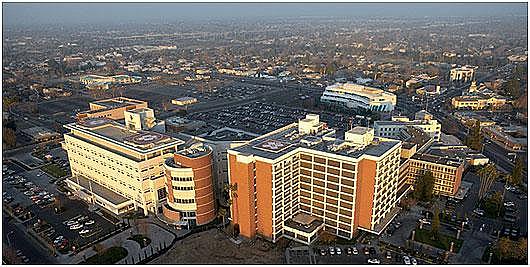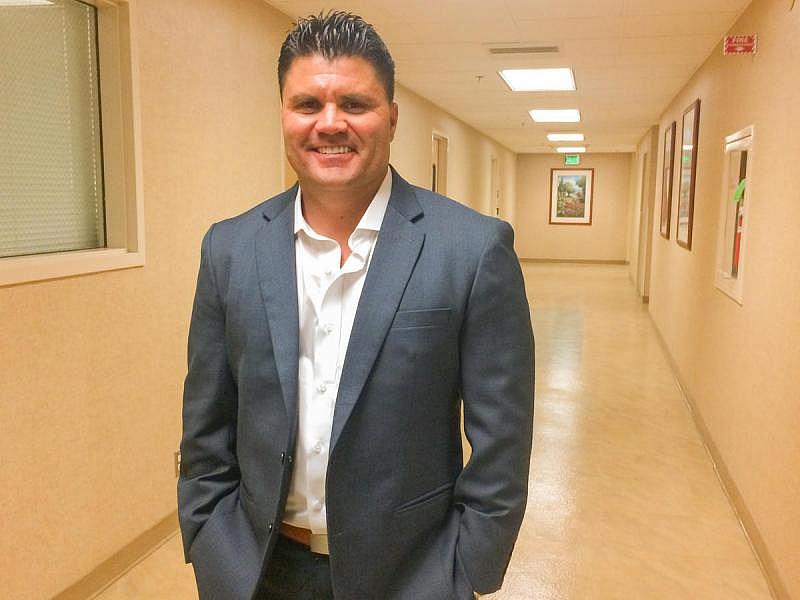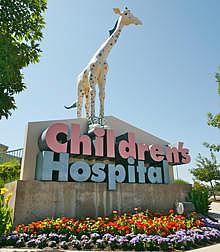With limited federal funding, Valley struggles to expand medical training programs
This article was produced as a project for the USC Center for Health Journalism’s California Fellowship.
Other stories in the series include:
When it comes to doctor access, the San Joaquin Valley is being left behind
Pharmacists are now poised to ease physician shortage—if only they could get paid for it

With the capacity for over 350 residents, the UCSF Fresno Center for Medical Education and Research, associated with Community Regional Medical Center, is the largest graduate medical education program in the San Joaquin Valley. Community Hospitals / UCSF Fresno
As we reported earlier this summer, the Fresno area could soon be home to two medical schools. While that may seem like a great opportunity for creating home-grown doctors, research suggests local residencies and fellowships could be more important for keeping doctors here. But the Valley lags behind the state in those training opportunities, too. In the second installment of Struggling For Care, we learn how local health leaders are working hard to expand those positions—despite a 20-year-old federal law that puts a limit on funding for medical training.
Community Regional Medical Center in downtown Fresno is a teaching hospital. Residents from UCSF Fresno go there for clinical hours in fields like family medicine, gastroenterology and psychiatry.
They also come for skills training—like an emergency medicine lab, in which dozens of residents in scrubs are poking instruments into what look like long, pink cuts of butchered meat. They’re pig tracheas, and they double as human airways for training purposes.
Dr. Andres Anaya is a third-year resident and one of the lab’s instructors. He’s all in on emergency medicine—“because it's rad,” he says. “It's perfect for people with my personality, which is, I like to see a lot of variety and a lot of different things.”
Dr. Andres Anaya, a third-year emergency medicine resident at UCSF Fresno, plans to remain in the Valley after finishing his training. Credit Kerry Klein / KVPR
In this room full of doctors from around the country, Anaya’s a local boy. “I was born and raised here in Fresno. I was actually born in this hospital.”
Anaya studied in San Jose and San Francisco, but his plan was always to come back here. “There's a huge need here in the valley for trained, qualified doctors,” he says. “All of my family is here, so this is where I feel I can contribute the most and also be close to my family.”
This is exactly what UCSF Fresno wants to hear. Dr. Michael Peterson is the school’s chief of medicine and associate dean. “Since our goal here is to produce physicians that are going to provide care in the Central Valley, to address the issue of the physician shortage, we want to do everything we can to make sure that we're bringing people in that we can predict are going to stay in the region,” Peterson says.
One predictor of where doctors practice is where they grew up, says Janet Coffman, a professor of health policy at UC San Francisco. However, she says, “one of the biggest drivers is where physicians are trained.”
Studies have shown around half of doctors practice not where they went to medical school, but where they finished their graduate training—in programs like residencies and fellowships. “Some of that is just, when people are coming out of residency, they're often early- to mid-30s,” Coffman says, “and they're at a stage where they're ready to be a little more settled.”
Here in the Valley, we have slots for about 750 residents and fellows. That may sound like a lot, but per capita, our share of residents is lower than the state average and far below California’s biggest metropolitan areas. Los Angeles County alone has 4,000 residents. But beefing up our graduate medical programs isn’t easy. A 20-year-old federal law actually limits how much the federal government will pay hospitals to train residents.
The traditional medical education programs have been complaining for decades that the cap in the funding formulas that come through the Medicare program have been massively inadequate to build the workforce that this country needs.--Stephen Schilling
So why would the government want to limit medical education? It all hinges on the Medicare program, which funds the lion’s share of graduate medical training. To understand what happened, it’s beneficial to look back at the Balanced Budget Act of 1997 and the economic landscape of the late 1990s.
For over a decade before Bill Clinton announced his budget act, Medicare costs had been rising. At the same time, there was no national doctor shortage. In fact, thanks to the expansion of managed care, researchers were predicting a surplus of doctors.
So, says Karen Fisher with the American Association of Medical Colleges, limiting residency programs through the Balanced Budget Act seemed like a painless way to slash Medicare spending. “Obviously, that didn't turn out to be the case,” Fisher says. “Managed care had a major backlash against it, the population started to get older, et cetera, and we started to see, not long after ‘97, probably in the early to mid 2000s, shortages starting to emerge.”
The act worked by telling teaching hospitals: However many residents you trained last year, that’s now your residency cap. That’s all Medicare will help you pay for. “And so, depending on what the hospital was training in 1996, that amount essentially was frozen, and continues to be frozen today,” she says.
There are some exceptions. Teaching hospitals in rural areas have slightly higher caps, and two specialties have no caps at all. Also, the cap applies only to hospitals, not to clinics or other health centers. Still, in the Valley, 90 percent of residency slots are in teaching hospitals because that’s where the infrastructure is.
However they’re distributed, says Stephen Schilling, the Bakersfield-based CEO of Clinica Sierra Vista, the Valley just doesn’t have enough. “The traditional medical education programs have been complaining for decades that the cap in the funding formulas that come through the Medicare program have been massively inadequate to build the workforce that this country needs,” Schilling says.
Depending on what the hospital was training in 1996, that amount essentially was frozen, and continues to be frozen today.--Karen Fisher
Since 2009, lawmakers across the country have tried to appropriate money for more residents. A House bill introduced earlier this year, H.R. 2267, proposes to raise the cap by 15,000 residents. One co-sponsor is Representative Ruben Kihuen of Nevada, a state that also struggles with physician access. “This is a desperately needed bill that would help us expand the amount of residencies not only in the state of Nevada but across the country,” Kihuen says. “So this is going to save us money in the long term and it's something that is long overdue.”
Lawmakers have until 2018 to move on the two bills, which no Valley lawmakers have yet co-sponsored. In 2015, an earlier version of the House bill earned close to 150 co-sponsors from both sides of the aisle—but it never came to a vote.
In the meantime, regions like ours do have options. Training programs can seek out alternative funding sources, and non-teaching hospitals can start new programs. If they do that, and seek Medicare funding, they have five years before they reach their own caps.
Valley Children’s Hospital in Madera recently accepted its first class of 13 pediatric residents. When full, the program will be able to train 39 residents. Credit Valley Children's Hospital
And it’s looking like that will happen. New programs at Saint Agnes Medical Center in Fresno, Madera Community Hospital and Valley Children’s Hospital in Madera could add more than 160 new residents to the Valley.
Plus, in 2010, the Affordable Care Act established a new class of program called Teaching Health Centers. The Valley’s three centers in Fresno, Bakersfield and Modesto have brought 66 residents into underserved areas. A handful of bills currently in Congress, some supported by local Congressmen Jeff Denham and David Valadao, aim to renew the program’s funding beyond their sunset next month.
As for Andres Anaya, his background and his choice of fellowship are keeping him around. “I'll be right here in the valley, that's for sure,” he says. “I'm not going anywhere.”
He’s still looking for a job for after he graduates, but to start, he’s worked out a volunteer position with a local SWAT team. He’s also plans to get involved with UCSF Fresno’s Doctors Academy, which aims to spark interest in medicine in kids as early as middle school.
[This story was originally published by KVPR.]

